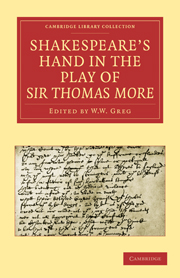Book contents
- Frontmatter
- PREFACE
- Contents
- PLATES
- I INTRODUCTION
- II THE HANDWRITINGS OF THE MANUSCRIPT
- III THE HANDWRITING OF THE THREE PAGES ATTRIBUTED TO SHAKESPEARE COMPARED WITH HIS SIGNATURES
- IV BIBLIOGRAPHICAL LINKS BETWEEN THE THREE PAGES AND THE GOOD QUARTOS
- V THE EXPRESSION OF IDEAS–PARTICULARLY POLITICAL IDEAS–IN THE THREE PAGES AND IN SHAKESPEARE
- VI ILL MAY DAY. SCENES FROM THE PLAY OF SIR THOMAS MORE
- VII SPECIAL TRANSCRIPT OF THE THREE PAGES
- Plate section
IV - BIBLIOGRAPHICAL LINKS BETWEEN THE THREE PAGES AND THE GOOD QUARTOS
Published online by Cambridge University Press: 06 December 2010
- Frontmatter
- PREFACE
- Contents
- PLATES
- I INTRODUCTION
- II THE HANDWRITINGS OF THE MANUSCRIPT
- III THE HANDWRITING OF THE THREE PAGES ATTRIBUTED TO SHAKESPEARE COMPARED WITH HIS SIGNATURES
- IV BIBLIOGRAPHICAL LINKS BETWEEN THE THREE PAGES AND THE GOOD QUARTOS
- V THE EXPRESSION OF IDEAS–PARTICULARLY POLITICAL IDEAS–IN THE THREE PAGES AND IN SHAKESPEARE
- VI ILL MAY DAY. SCENES FROM THE PLAY OF SIR THOMAS MORE
- VII SPECIAL TRANSCRIPT OF THE THREE PAGES
- Plate section
Summary
When my attention was first seriously directed to the problem of the More Addition, I had already, at Mr Pollard's suggestion, undertaken a bibliographical enquiry into the nature of the ‘copy’ used for the Good Shakespearian Quartos, with a view to discovering if possible something about the character of Shakespeare's manuscripts. At the best, the first edition of one of Shakespeare's plays was printed direct from his autograph; and Mr Pollard has happily shown us reason for believing that this best occurred more frequently than has hitherto been suspected. At the worst, it was printed from a transcript of the original. Yet even if this worst were found to account for most of the quarto productions, such a situation need not lead us to despair. It is exceedingly unlikely that a copyist would obliterate all traces of Shakespeare's penmanship in making his transcript; and the presence of a copyist simply means that two men stand between the printed text and the original instead of one, viz. the compositor. Indeed, the fact that some of the Bad Quartos, which are almost certainly based in part upon transcripts from an original manuscript, occasionally exhibit passages closely resembling their counterparts in the Good Quartos, in punctuation, spellings or misprints, goes to show that Shakespeare's pen could still influence the printed page, even after the lines of his verse had passed through two heads other than his own.
- Type
- Chapter
- Information
- Shakespeare’s Hand in the Play of Sir Thomas More , pp. 113 - 141Publisher: Cambridge University PressPrint publication year: 2010First published in: 1923



